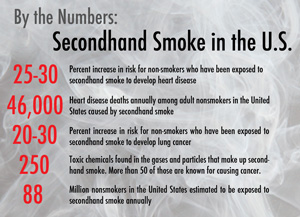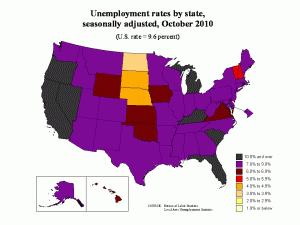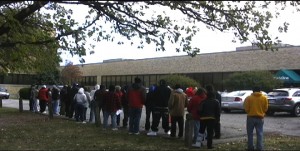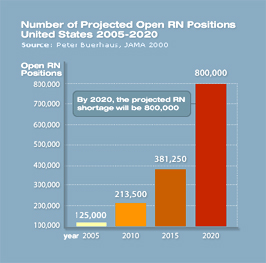Possible ban could lower state smoking rate
In response to Indiana’s rising smoking rates, state legislators will again propose a bill in January that would place a statewide ban on smoking in all public areas and workplaces.

23 percent of Hoosier adults are smoking, six percent higher than the national average. State health officials say that a statewide smoking ban would lower the rate. (Photo courtesy of mctcampus.com)
The smoking rate in Indiana is 6 percent higher than the national average. According to state health officials, 23 percent of Hoosier adults light up, compared to the national average of 17 percent.
No developments in smoking laws on the statewide scale have been made since data was last collected, which is why Karla Sneegas, director of the Indiana Tobacco Prevention and Cessation Agency, does not understand why Indiana’s rate is high.
“It should not be that high,” Sneegas said. “There is no reason for our rates to be higher than the national rate.”
Current state law ‘ineffective’
Supporters of a statewide smoking ban say it would keep the rate from getting any higher.
“The statistics really show that a ban means lower rates,” Sneegas said. “It’s that simple and there’s really no evidence saying otherwise.”
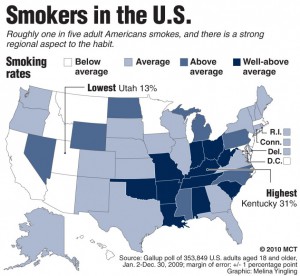
States with statewide smoking bans have lower smoking rates, according to a recently released study. (Graphic courtesy of mctcampus.com)
Twenty-seven states in the country have a complete ban in all public areas and workplaces, including restaurants and bars. The smoking rate is significantly lower in states with smoking bans.
Utah had the lowest rate, with 9.3 percent of adults smoking, while California and Maryland had rates of 14.8 and 14.9 percent respectively.
While 30 different localities and cities in Indiana have various types and levels of smoking bans, there is not a statewide ban to prohibit smoking in all places of employment.
Indiana is covered by the 1993 federal Clean Indoor Air Law, which prohibits smoking in schools and childcare and healthcare facilities.
Liza Sumpter of the Marion County Tobacco Control Program has criticized the law for not being effective enough in the efforts to lower the smoking rate.
“Putting laws here and not there is just not good enough,” Sumpter said. “It needs to be everything, because it’s not people of one county [who are] affected by secondhand smoke. The side effects impact people everywhere.”
A statewide ban would lower the rate in Indiana because it would be more inconvenient for Hoosiers to smoke, Sumpter said.
“When you have a ban, you find that people are less likely to smoke,” she said. “It’s not fun and it’s not cool to have to go out and smoke in the rain or in the snow, and a ban would make that a requirement if you wanted to smoke.”
In Marion County, smoking is prohibited in places of employment, but does not cover bars, taverns, bowling alleys, hotels and tobacco bars.
Of the 60 biggest cities in America, Indianapolis is one of 16 without a complete smoking ban in all places of employment.
A bill in the works
State legislators have introduced bills that would ban smoking in public areas and workplaces every year for the past three years.
The senate or the house has killed every one of those bills.
Rep. Charlie Brown (D-Gary) authored the bill presented in the most recent general assembly session. House Bill 1131 passed in the House 73-26, but died when it reached the senate in early February.
Brown, who has been working for five years to pass the bill, said he is hopeful it will eventually pass.
“The issue has a strong possibility of passing in the senate than it did in the past,” Brown said in a recent interview with the Indiana Economic Digest.
Sumpter said she remains positive that Brown’s next attempt will be successful.
“I think if we just keep pushing it, it will get in the hands of the governor,” Sumpter said.
Advocates on both sides of the fence
In the United States, secondhand smoke is responsible for almost 50,000 deaths from heart disease and lung cancer.
In Indiana, secondhand smoke is responsible for 9,700 deaths annually, according to statistics released by the Centers for Disease Control.
Secondhand smoke costs $47 million in health care, loss of life and absenteeism costs every year.
“[Absenteeism] is a [cost] that is often overlooked, but someone has to pay the wages of those who miss work due to smoke-related illnesses,” Sumpter said.
Bruce Hetrick advocates a smoking ban. He said he thinks one should have been in place to avoid the effects of secondhand smoke.
“Quite frankly, the state of Indiana is killing people by allowing people to smoke in public areas,” Hetrick said.
Hetrick became an advocate after his wife, Pam Klein, died at age 49. She was diagnosed with a lung cancer usually found in smokers.
“She was around people who smoked all the time,” Hetrick said. “She had never smoked a day in her life. But she got cancer and it killed her.”
While some people are in favor of a statewide smoking ban, others fear that a ban would damage the livelihood of businesses across the state.
“Of course a ban would hurt my business,” Hal Yeagy, owner of the Slippery Noodle Inn in downtown Indianapolis, said. “We’re a tavern. We have live music. People come to drink, to socialize and to relax. If we take away any of those things, we lose part of what we are.”

Hal Yeagy, owner of The Slippery Noodle Inn is one advocate against a statewide smoking ban. (Photo courtesy of slipperynoodle.com.)
The government’s involvement in the issue is what bothers Yeagy and other advocates for not passing a ban, he said.
“Who are they to tell me what I can and cannot do in here?” Yeagy said. “I pay the bills, I pay the taxes. It’s mine.”
The decision to come into the bar is in the hands of the consumer, and Yeagy said the other decisions should be in their hands, too.
“I’m sympathetic to people who have suffered because of smoking and the problems it might have caused,” Yeagy said. “But as far as I am concerned, you have a choice if you want to come into my bar. We don’t force anyone to come in here and we don’t force anyone to work here.”
The unclear future of a smoking ban
Brown plans to propose a statewide ban again in January when the Indiana General Assembly convenes.
Sumpter said she is hopeful this time will be the last.
“Indiana’s never really been really innovative as far as getting into things quickly, but I just know it will be taken care of,” Sumpter said. “I have a good feeling that we’re moving in the right direction.”
What do you think?
 Share your thoughts and keep updated on Indiana laws on Twitter!
Share your thoughts and keep updated on Indiana laws on Twitter!
Tell the author what YOU think about a possible smoking here!
Additional readings and resources
Northwestern Indiana Times covered the possible statewide ban in a recently-published article.
The Indianapolis Business Journal examined the possible affects on businesses across the state in an article published in November.
WANE, a news channel out of Fort Wayne, Ind. covered the story before the bill died in the senate.
An article published on heartland.org presented a case against the ban and provides links to further readings against smoking bans.
Watch a video version of this story below

